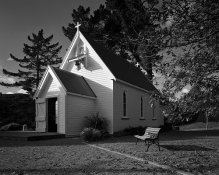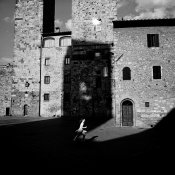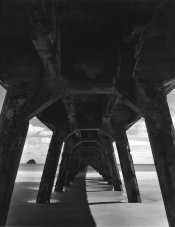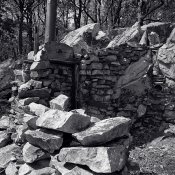brian steinberger
Subscriber
I'm trying to figure out what makes a great photograph which was made in bright sunlight; a print that makes you squint when you look at it. It seem to me that a lot of black & white photography is made in overcast or diffuse lighting. And while I've seen many photographs that have been taken is bright sunlight, only a few truly posses that feeling of bright sunlight. I have attached a few great examples.
Exposure:
Exposure in bright sunlight can be very difficult if allowing in-camera metering. Spot metering is a little easier. Is the key to a great sunny photograph the black detail-less shadows? Or the bright detail-less highlights? Or both?! Seems many photographers (Ansel Adams certainly) try to get as much detail in the shadows and highlights, compressed the tonal scale much, whether it be use of compensating developers, water bath, stand-development, etc. I find a great sunlit photograph to have black areas of detail-less shadows, though this is just my personal preference. Highlights can also fall quite high on the exposure scale, though through controls already mentioned can be controlled.
How are you guys exposing your sunlit photographs? Are you placing shadows on zone II? Maybe placing highlights on zone VIII? Reduced agitation in development most of the time?
Printing:
Then when it's time to print, I usually start with my lightest tone, usually a zone VIII in a sunlit photograph and find my exposure which makes it just visible on the paper, then use contrast to set the blacks. Many times though with my sunlit photos the whites are either too bright or not quite bright enough. It seems that it's a fine line between success and failure.
How are you guys printing your bright sunlit photographs? Are you letting some of your highlights go pure paper base white? Are you letting some shadows go to detail-less blacks?
I understand everyone's process is different. I'd just like to get an idea of other thoughts on bright sun photographs when it comes to exposure and printing.
Exposure:
Exposure in bright sunlight can be very difficult if allowing in-camera metering. Spot metering is a little easier. Is the key to a great sunny photograph the black detail-less shadows? Or the bright detail-less highlights? Or both?! Seems many photographers (Ansel Adams certainly) try to get as much detail in the shadows and highlights, compressed the tonal scale much, whether it be use of compensating developers, water bath, stand-development, etc. I find a great sunlit photograph to have black areas of detail-less shadows, though this is just my personal preference. Highlights can also fall quite high on the exposure scale, though through controls already mentioned can be controlled.
How are you guys exposing your sunlit photographs? Are you placing shadows on zone II? Maybe placing highlights on zone VIII? Reduced agitation in development most of the time?
Printing:
Then when it's time to print, I usually start with my lightest tone, usually a zone VIII in a sunlit photograph and find my exposure which makes it just visible on the paper, then use contrast to set the blacks. Many times though with my sunlit photos the whites are either too bright or not quite bright enough. It seems that it's a fine line between success and failure.
How are you guys printing your bright sunlit photographs? Are you letting some of your highlights go pure paper base white? Are you letting some shadows go to detail-less blacks?
I understand everyone's process is different. I'd just like to get an idea of other thoughts on bright sun photographs when it comes to exposure and printing.


















